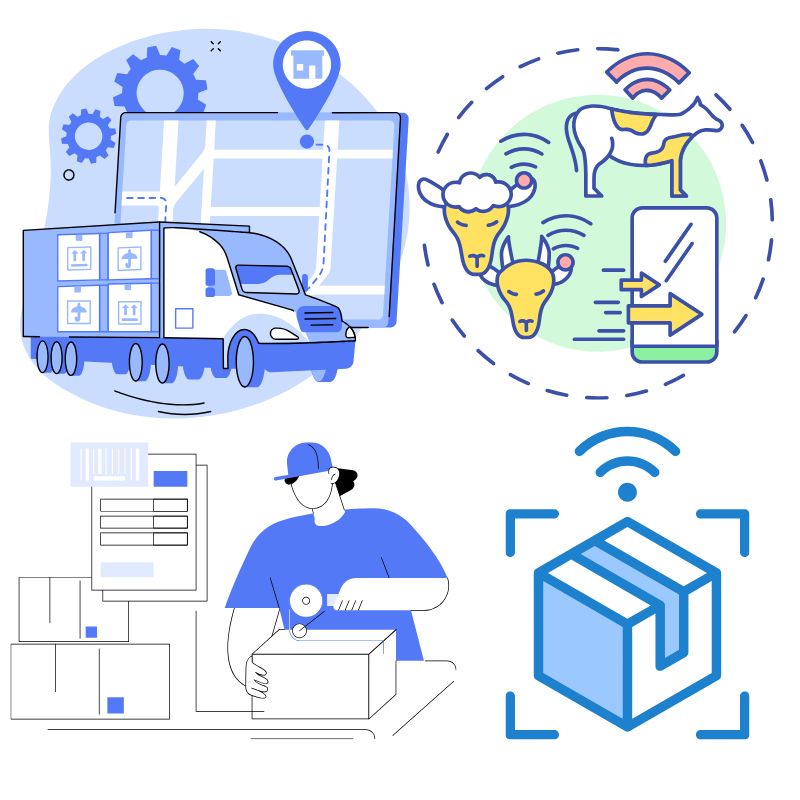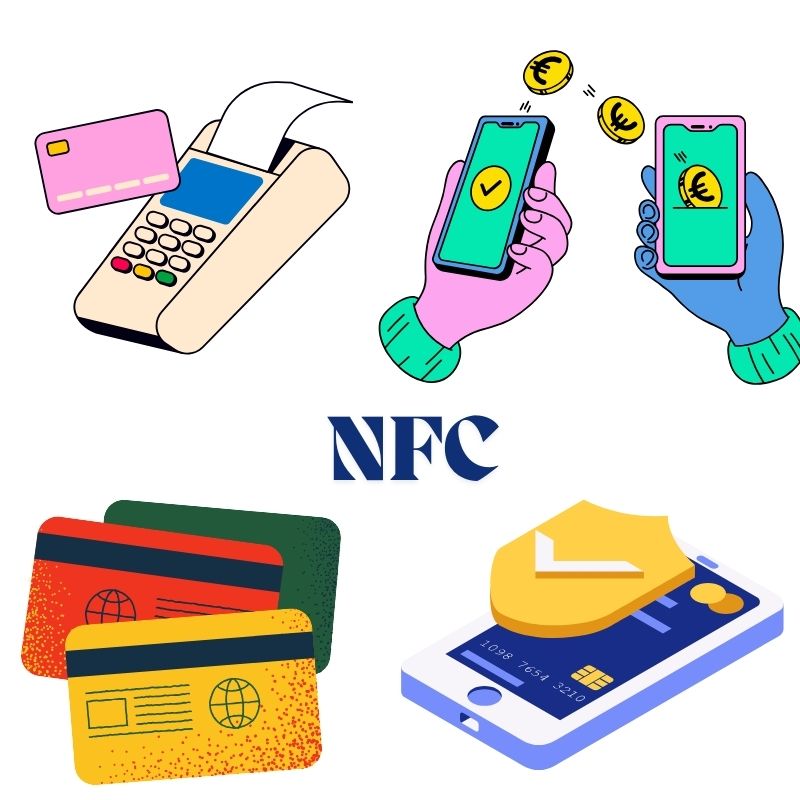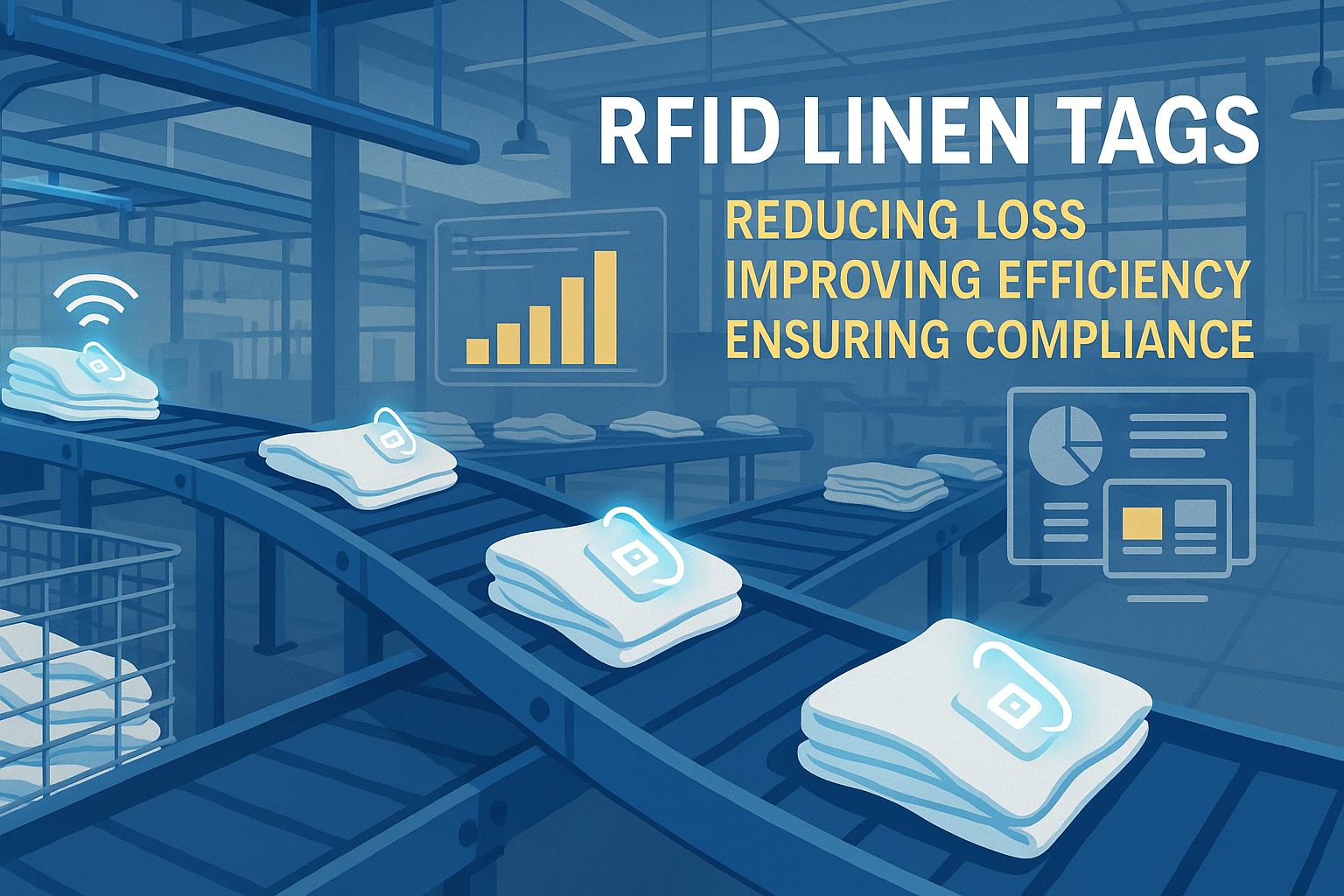
NFC와 RFID의 차이점은 무엇인가요?
목차
NFC와 RFID: 주요 차이점, 적용 분야 및 선택 기준 (2025 가이드)
재고 추적부터 비접촉 결제에 이르기까지, 이러한 무선 통신 방식들은 산업 현장에서 프로세스 자동화, 오류 감소, 보안 강화를 돕고 있습니다.
이 가이드는 RFID와 NFC의 차이점, 작동 방식, 적용 분야, 그리고 2025년 현재 여러분의 요구에 가장 적합한 기술이 무엇인지에 대해 상세히 설명합니다.

RFID와 NFC란 무엇인가요?
RFID(무선 주파수 식별)
RFID는 무선 주파수를 이용해 RFID 태그와 리더기를 통해 물체를 자동으로 식별하고 추적합니다. 물류, 소매, 제조, 의료 등 다양한 산업 분야에서 자산 추적 및 공급망 운영 효율화를 위해 널리 사용됩니다.
- 주파수 대역: 저주파(LF), 고주파(HF), 초고주파(UHF)
- 읽기 범위: 최대 100미터 (활성 태그)
- 태그: 패시브(무전원) 또는 액티브(전원 공급형)
- 사용 사례: 재고 관리, 자산 추적, 접근 제어
NFC (근거리 무선 통신)
NFC는 RFID의 특수한 하위 집합으로, 13.56MHz(고주파)에서 작동합니다. 일반적인 RFID와 달리 NFC는 매우 가까운 거리(일반적으로 4cm 미만)에서 기기 간 양방향 통신을 가능하게 합니다. 모바일 결제나 디지털 명함과 같은 안전하고 빠른 데이터 교환에 널리 사용됩니다.
- 주파수 대역: 고주파 (13.56 MHz)
- 범위: 몇 센티미터 이내
- 상호작용성: 양방향 통신 지원
- 사용 사례: 비접촉 결제, 스마트폰 페어링, 대중교통
NFC 대 RFID: 차이점은 무엇인가요?
RFID와 NFC의 차이는 범위, 상호작용성, 전력, 응용 분야에 있습니다. 다음은 간단한 비교표입니다:
| 특징 | 무선 주파수 식별(RFID) | 근거리 무선 통신 |
|---|---|---|
| 주파수 대역 | 저주파, 고주파, 극초단파 | 고주파(13.56MHz) |
| 읽기 범위 | 최대 100미터 | 몇 센티미터 이내 |
| 의사소통 | 일방통행 (대부분) | 양방향 |
| 전원 | 수동적 또는 능동적 | 일반적으로 수동적 |
| 응용 프로그램 | 재고, 공급망, 접근 제어 | 모바일 결제, 데이터 공유 |
| 상호 작용성 | 낮은 | 높음 (사용자-기기 상호작용) |
- “RFID는 대규모 자산 추적에 이상적이며, NFC는 모바일 결제와 같은 안전하고 근거리 상호작용을 위해 설계되었습니다.”
RFID 기술의 작동 방식
RFID 시스템은 세 가지 핵심 구성 요소에 의존합니다:
- RFID 태그: 상품 정보 저장 (읽기 전용 또는 읽기/쓰기 가능).
- RFID 리더기: 수동형 태그에 전원을 공급하고 데이터를 검색하기 위해 신호를 방출합니다.
- 소프트웨어 시스템: 수집된 데이터를 해석하고 관리합니다.
RFID 태그의 종류
- 수동형 RFID 태그: 내장 배터리가 없으며, RFID 리더기의 신호로 전원을 공급받습니다.
- 능동형 RFID 태그: 자체 전원 공급 장치를 갖추어 더 긴 거리와 빈번한 데이터 업데이트가 가능합니다.
RFID 및 NFC 리더기는 용도에 따라 휴대용 및 고정형으로 제공됩니다.
NFC 작동 원리
NFC 기술은 두 개의 NFC 지원 기기 간 또는 기기와 NFC 태그 간의 근거리 통신을 가능하게 합니다.
NFC의 장점:
- 탭 앤 고 간편함: 페어링이나 스캔이 필요 없습니다.
- 고보안성: 비접촉식 금융 거래에 이상적입니다.
- 양방향 통신: 대부분의 RFID 시스템과 달리 데이터가 양방향으로 흐를 수 있습니다.
NFC 및 RFID 리더기 장치는 빠르고 안정적이며 안전한 상호작용을 위해 스마트폰, POS 단말기, 교통 게이트에 점점 더 많이 통합되고 있습니다.
RFID의 응용 분야
RFID와 NFC는 모두 다양한 애플리케이션을 지원하지만, RFID의 장거리 및 유연성 덕분에 다음에 이상적입니다:
재고 관리
- 실시간 업데이트
- 창고 간 자동 추적
자산 추적
- 의료 장비, 도구 또는 차량을 모니터링하다
- 물류 및 의료 분야의 효율성 증대
접근 제어
- RFID 키 카드, 열쇠고리 또는 배지를 사용하십시오
- 보안 건물 또는 구역에 대한 출입 통제
NFC의 응용 분야
NFC의 안전하고 근거리 통신 기능은 개인용 및 공공용 애플리케이션에서 두각을 나타냅니다:
모바일 결제
- 애플 페이, 구글 페이, 삼성 페이.
- 몇 초 만에 안전하게 거래하세요.
스마트 기기 및 마케팅
- 탭하여 앱을 실행하거나 연락처 정보를 공유하세요.
- 제품 정보 또는 체크인을 위한 스마트 태그.
교통 시스템
- 비접촉식 교통카드.
- 지하철 및 버스 네트워크에서의 편리한 승차.

NFC 대 RFID: 어떤 것을 사용해야 할까?
| 사용 사례 | 최고의 기술 |
|---|---|
| 장거리 추적 | 무선 주파수 식별(RFID) |
| 재고 또는 공급망 운영 | 무선 주파수 식별(RFID) |
| 안전한 개인 거래 | 근거리 무선 통신 |
| 모바일 결제 및 신원 확인 | 근거리 무선 통신 |
| IoT 스마트 자동화 | 둘 다 |
수천 개의 자산을 관리한다면 RFID가 최적의 선택입니다. 휴대폰을 탭하는 것과 같은 개별적이고 안전한 상호작용에는 NFC가 확실한 선택입니다.
사물인터넷(IoT)에서의 NFC 및 RFID
RFID와 NFC는 사물인터넷 생태계의 기반이 되어 물리적 대상이 디지털 시스템과 “소통'할 수 있게 합니다.
- IoT에서의 RFID공급망과 생산 현장의 물품을 모니터링합니다.
- IoT에서의 NFC스마트폰을 통해 안전한 기기 페어링, 스마트 홈 접근 및 실시간 제어를 가능하게 합니다.
“NFC와 RFID 태그의 결합은 물리적 자산을 클라우드에 연결함으로써 사물인터넷(IoT)을 변화시키고 있습니다.”
NFC 및 RFID 성능에서 주파수의 역할
주파수를 이해하면 올바른 시스템을 선택하는 데 도움이 됩니다:
- LF (125–134 kHz) – 근거리, 출입 통제에 사용됨
- 고주파(13.56MHz) – RFID와 NFC 모두에서 사용됨
- UHF(860~960MHz) – 장거리, 공급망에 이상적
각 주파수는 서로 다른 범위와 읽기 속도를 지원하므로, RFID 및 NFC 리더 선택은 시스템 성능에 중요합니다.
NFC 및 RFID에 대한 FAQ
RFID와 NFC의 주요 차이점은 무엇인가요?
NFC는 RFID의 하위 집합입니다. RFID가 더 긴 거리와 단방향 통신을 지원하는 반면, NFC는 양방향 단거리 상호작용을 위해 설계되었습니다.
NFC 태그와 RFID 태그는 서로 대체하여 사용할 수 있나요?
항상 그런 것은 아닙니다. NFC는 HF(고주파)에서만 작동하는 반면, RFID는 LF(저주파), HF(고주파) 또는 UHF(초고주파)를 사용할 수 있습니다. NFC 태그는 모든 RFID 리더기가 아닌 NFC 리더기에서만 작동합니다.
RFID 태그는 안전한가요?
암호화되지 않은 수동형 RFID 태그는 취약할 수 있습니다. NFC는 특히 금융 거래에 대해 더 많은 내장형 보안을 제공합니다.
NFC 및 RFID 리더란 무엇인가요?
이것은 RFID 또는 NFC 태그를 읽는 데 사용되는 장치입니다. 많은 최신 스마트폰은 비접촉식 작업을 위한 NFC 리더기로 기능합니다.
NFC 결제 방식은 어떻게 작동하나요?
기기들은 NFC를 이용해 암호화된 결제 정보를 호환 단말기로 무선 전송합니다 — 물리적 접촉이 필요하지 않습니다.
RFID 기술로 가장 큰 혜택을 보는 산업은 무엇인가요?
소매, 의료, 물류, 제조 및 창고업은 자동화와 가시성을 위해 RFID를 활용합니다.
최종 생각
RFID와 NFC 모두 상당한 가치를 제공합니다—팔레트 추적이든 스마트폰으로 결제하든 상관없이. 선택은 운영 요구사항에 부합해야 합니다:
- 광범위하고 자동화된 추적을 위해서는 RFID를 선택하십시오.
- 안전한 근거리 상호작용을 위해서는 NFC를 선택하세요.
RFID 및 NFC 태그가 IoT와 함께 진화함에 따라, 지금이 바로 이를 업무 프로세스에 통합하기에 완벽한 시기입니다.
귀사에 적합한 NFC 또는 RFID 시스템을 선택하는 데 도움이 필요하신가요?
문의하기 오늘 바로 확인하거나, 당사의 모든 NFC 및 RFID 리더기와 태그 제품군을 살펴보세요.

레이 저우
이 글은 업계에서 10년 이상의 경력을 쌓은 RFID 기술 전문가인 Ray Zhou가 작성했습니다.
댓글
인기상품

RFID 기반 폐기물 관리란 무엇인가
모든 쓰레기통이 말을 하는 도시를 상상해 보세요. 말 그대로가 아니라, 작은 칩을 통해 시스템에 쓰레기통이 가득 찼을 때, 비워졌을 때, 그리고 어디로 이동했는지를 알려주는 것입니다. 이것이 바로 오늘날 RFID 폐기물 관리가 수행하는 역할입니다.

볼트 씰이란 무엇이며 어떤 용도로 사용되나요? | 전체 가이드
글로벌 무역 및 물류에서 볼트 씰은 화물의 보안과 규정 준수에 중요한 역할을 합니다. 이 작지만 강력한 장치는 운송 컨테이너, 트레일러 및 화물 도어를 변조 방지 메커니즘으로 잠그도록 설계되었습니다.

RFID 카드 프로텍터란 무엇인가요? 장점, 사용 사례 및 구매 가이드
RFID(무선 주파수 식별) 기술은 신용카드, 신분증, 대중교통 패스, 호텔 객실 열쇠 등 어디에나 있습니다. 이 기술은 속도와 편리함을 제공하지만 "스키밍"이라는 새로운 종류의 디지털 도난에 대한 문을 열어주기도 합니다. 이것이 바로 RFID 카드 프로텍터가 필요한 이유입니다.

이벤트용 RFID 손목 밴드: 주최자를 위한 대량 구매 가이드
이벤트용 RFID 손목 밴드는 콘서트, 축제, 스포츠 경기장에서 더 빠른 입장, 사기 방지, 현금 없는 결제가 필요한 주최자가 선호하는 솔루션으로 자리 잡고 있습니다. 종이 티켓이나 QR코드와 달리 이러한 스마트 손목 밴드는 내장된 칩을 사용하여 액세스를 간소화하고 거래를 보호하며 게스트 경험을 개선합니다.

윈드스크린의 RFID 태그가 차량 출입 통제 및 통행료 시스템을 개선하는 방법
오늘날과 같이 빠르게 변화하는 세상에서는 차량 식별이 빠르고 안전하며 비접촉식으로 이루어져야 합니다. 윈드스크린의 RFID 태그는 차량을 정차하지 않고도 통행료 징수, 주차, 게이트 출입을 관리할 수 있는 안정적인 방법을 제공합니다.

상업용 세탁에서 RFID 린넨 태그의 이점
병원, 호텔 또는 대형 세탁 서비스에서 세탁물을 관리하는 것은 큰 일입니다. 매일 수천 장의 시트, 수건, 유니폼을 세탁하고 분류하여 다시 보내야 합니다. 하지만 린넨 분실, 분류 실수, 수작업 계수 등의 문제로 인해 회사에 많은 비용이 발생할 수 있습니다. 예를 들어, 중형 호텔의 경우 린넨 분실로 인해 매년 100만 달러 이상의 손실이 발생할 수 있습니다.
이것이 바로 RFID 리넨 태그가 필요한 이유입니다.
태그
관련 블로그

RFID 기반 폐기물 관리란 무엇인가
모든 쓰레기통이 말을 하는 도시를 상상해 보세요. 말 그대로가 아니라, 작은 칩을 통해 시스템에 쓰레기통이 가득 찼을 때, 비워졌을 때, 그리고 어디로 이동했는지를 알려주는 것입니다. 이것이 바로 오늘날 RFID 폐기물 관리가 수행하는 역할입니다.

볼트 씰이란 무엇이며 어떤 용도로 사용되나요? | 전체 가이드
글로벌 무역 및 물류에서 볼트 씰은 화물의 보안과 규정 준수에 중요한 역할을 합니다. 이 작지만 강력한 장치는 운송 컨테이너, 트레일러 및 화물 도어를 변조 방지 메커니즘으로 잠그도록 설계되었습니다.

RFID 카드 프로텍터란 무엇인가요? 장점, 사용 사례 및 구매 가이드
RFID(무선 주파수 식별) 기술은 신용카드, 신분증, 대중교통 패스, 호텔 객실 열쇠 등 어디에나 있습니다. 이 기술은 속도와 편리함을 제공하지만 "스키밍"이라는 새로운 종류의 디지털 도난에 대한 문을 열어주기도 합니다. 이것이 바로 RFID 카드 프로텍터가 필요한 이유입니다.




